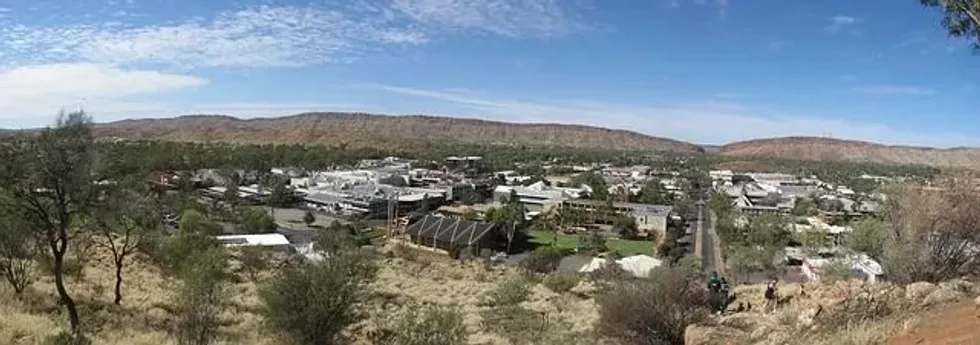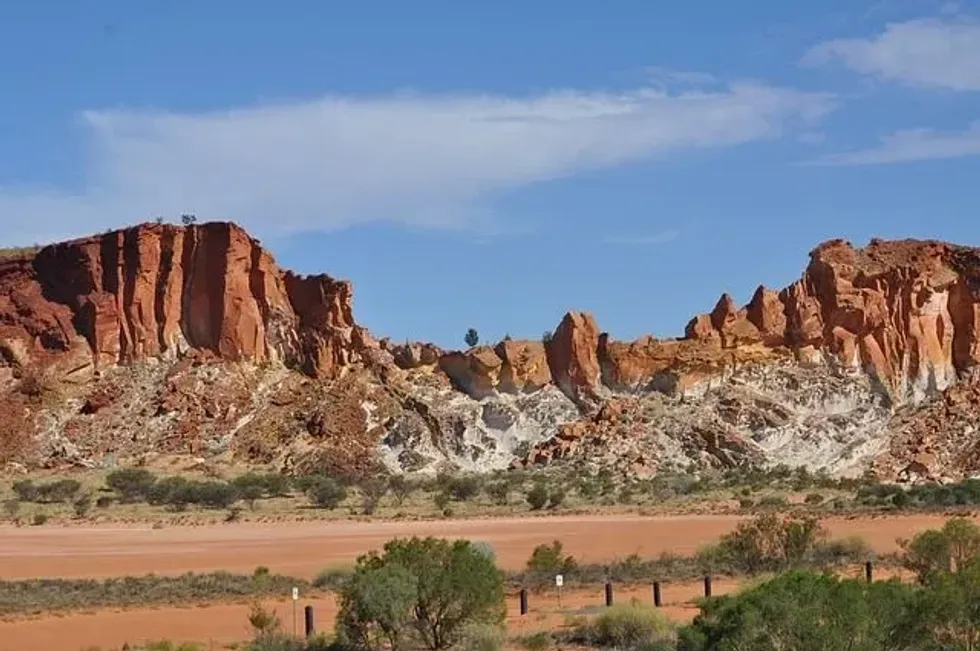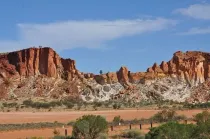201 Alice Springs Facts You Should Know About The Australian Town

Alice Springs is the second-largest populated town in Australia after the Northern Territory's capital, Darwin.
It is a contemporary town with all the city facilities and is located right in the center of the Australian continent. Alice Springs is the only central town and service center in a neighborhood the size of Texas.
Alice Springs was referred to as Stuart until August 31, 1933. Surveyor William Whitfield Mills named Stuart as 'Alice Springs', honoring Lady Alice Todd, spouse of Sir Charles Todd, who was a pioneer in the telegraph.
It is informally known as 'The Alice' or simply 'Alice'. Alice Springs is a small town with a big heart, ensconced in the epicenter of Australia's unique outback and mesmerizingly beautiful mountain ranges.
This town assimilates the unique Australian spirit, ranging from the desert landscapes to the aboriginal cultures.
These different elements are an intrinsic part of life for these Australians. Inside Alice Springs town, you'll find an extensive array of activities that include hot air balloons at the break of dawn, and camel rides.
As recorded in the year 2020, the approximate population of Alice Springs was about 31,120. It stands at an elevation of 1840 ft (560.8 m) above sea level.
It has a total area of 57.14 sq mi (148 sq km). The residents of Alice Springs follow the Australian Central Standard Time. From backpackers' abodes to the exclusive hotel accommodations, Alice Springs extends its arms widely to any of its visitors.
If you enjoyed our article, please check out more exciting articles on Christmas Island facts and Australia facts.
Fun Facts About Alice Springs
Alice Springs is said to have more outstanding art galleries and centers per capita than any other region in Australia. The enigmatic town is the best destination for understanding and investing in traditional and contemporary Aboriginal art.
If one is looking for quality Aboriginal art that directly benefits the local Aboriginal population, this is the place to go.
Alice Springs is the closest Australian town to each of the beaches within the country. The Northern Territory is famous for its many golf courses, and the Alice Springs golf course is ranked among the top ten desert courses globally.
Alice Springs is so cut off from the remainder of the Central Australian country, and due to its low population, there isn't much association with festivals. Several events are held throughout the year, including the incredibly popular Camel Cup, the pretentiously artistic Desert Festival, and also the Parrtjima Festival of Light, to name a few.
One of the interesting Alice Springs facts is that, apart from golf, Alice Springs has a high rate of participation in various sports, including tennis, hockey, football, basketball, soccer, cricket, rugby, and boxing. In terms of both sport and participation, Australian Rules Football is the most popular sport in Alice Springs.
The Central Australian Football League was formed in 1947, and it has numerous teams. The sport is prevalent in indigenous and remote communities.
Traeger Park is the local stadium that has a 10,000 seat capacity and is designed to host the Australian Football League. At present, it is the home of the Northern Territory Thunder.
An Australian Football League pre-season regional challenge match conducted in 2004, between Collingwood Football Club and Port Adelaide Football Club attracted a capacity sell-out crowd. Other sports held at the Traeger Park stadium include cricket, tennis, boxing, swimming, baseball, squash, and badminton.
Cricket is also one of the most famous sports in Alice Springs and is played in Traeger Park. The first cricket tournament, called the 'Imparja Cup Cricket Carnival', was played in 1994.
This cricket carnival attracts several indigenous teams from all across Australia. The Wests CC, Rovers CC, RSL Works CC, and the Federal Demons CC are the four leading clubs.
Soccer is widely prevalent among children and is played by many. Henley-on-Todd, also referred to as the Todd River Race, is a unique sporting event that is held annually.
It is a sand river race with boats that are bottomless, and this sport remains the sole dry river regatta in the world. The Camel Cup is another intriguing event hosted in Alice Springs featuring camel races.
On the occasion of the Queen's Birthday during the long weekend, the annual Finke Desert Race is conducted.
This race is an off-road race, starting from Alice Springs to the Finke community and back to Alice Springs the following day. The length of this race is roughly around 311 mi (500 km).
This sport is a special attraction for the spectators who camp along the entire length of the track, and around 500 competitors every year make it to this most significant and large sporting event in the Alice Springs calendar.
Historical Facts About Alice Springs
Alice Springs started as an Overland Telegraph Station in 1871 and grew swiftly when connected to the remainder of Australia by the Ghan train line, which opened during the early 20th century.
The Arrernte Aboriginal residents are the original owners of Alice Springs. The Arrernte meaning for 'Alice Springs' is 'Mparntwe' (pronounced mbarn-twa), which was created by several ancestral figures' actions that included the caterpillar beings Ayepe-arenye, Utnerrengatye, Ntyarlke, and the MacDonnell Ranges.
Alice Springs is like an oasis for restaurants and cafes within the Northern Territory, otherwise a sea of red sand and rock.
The desert of Central Australia surrounding Alice Springs was the habitat of the Arrernte Aboriginal Australians for thousands of years before the arrival of the first Europeans. In fact, archaeological evidence suggests that serious settlements for perhaps 30,000 years inhabited these aboriginal lands.
This proves that Alice Springs is one of the world's oldest continually occupied places. In Central Australia, there are three major groups: the Western, Eastern, and Central Arrernte people.
They are also called Aranda, Arunta, and other similar names. The five prominent dialects of the Arrernte language are as follows; South-eastern, Northern, Eastern, North-eastern, and Central.
Arrernte country is quite diversified with many mountain ranges, waterholes, and gorges, which open up a spread of natural habitats. As per the Arrernte traditional stories, the landscape was shaped by caterpillars, wild dogs, traveling boys, two sisters, euros, and other ancestral figures within the desert surrounding Alice Springs.
Emily Gap, Anzac Hill, and Billy Goat Hill are a few of the sites of traditional importance in and around Alice Springs.
The Alice Springs Campus is home to several historic tourist attractions. The Adelaide House is one of them, dating back to the '20s when it was the primary purpose-built hospital in this isolated town. Stuart Town Gaol is one of the oldest surviving buildings built in the early 20th century and is now owned by the National Trust.
The Olive Pink Botanical Gardens are located in the town center, close to the scenic Todd River, and have numerous substantial native trees.
The Old Courthouse was constructed in 1928 as the administrator's office for the Alice Springs area of Australia, before becoming the Alice Springs Courthouse until 1980, and finally the home of the National Pioneer Women's Hall of Fame.
Other favored attractions for tourists visiting Alice Springs would be the Alice Springs Desert and the Alice Springs district of Central Australia, which include bushwalking, one of the most effective ways to appreciate the native flora and fauna, beautiful scenery, and breathtaking landscapes.
The Alice Springs Reptile Centre is a well-liked attraction for children visiting the Alice Springs Desert Park.
The Alice Springs Desert Park is an outsized wildlife reserve showcasing the local wildlife and birds of prey, and the Frontier Camel Farm, with its fun camel rides and a small museum.
The Road Transport Hall of Fame features an unlimited collection of historic vehicles, including vintage cars, motorcycles, and early trains. Also, the town's golf club is an exceptional 18-hole course that is widely considered one of the most influential and scenic golf courses among the Alice Springs indigenous communities.
Facts About Alice Springs' Demographic
Alice Springs attracts Aboriginal people from across the world and that is the reason it is considered the regional epicenter of Central Australia. One can see many Aboriginal residents visiting the town to avail themselves of its services, like taking the suburbs to town camps.
The Central Arrernte people are considered the authentic owners of the Alice Springs area. Alice Springs is also the largest town in Central Australia, with speakers of languages like Ngaanyatjarra, Alyawarre, Warlpiri, and Kaytetye residing here.
Alice Springs has been a home for many Americans since the United States Air Force had its squadron named Detachment 421 established in 1954. This region in Alice Springs is referred to as 'The Det' or as 'Det 421'.
On July 1, 1995, the Alice Springs Town Council endowed 'The Det' with the privilege of entry to Alice Springs to commemorate the long-lasting friendship with the community.
Around 2,000 Alice Springs residents gained American citizenship as well. Many of them, joined by a few Australians, observe the American public holidays, which also include July 4 and Thanksgiving.
The Chinese, Vietnamese, Sudanese, Thai, and Indian groups are the other communities that have found abode in Alice Springs. These communities have enhanced the gastronomical dynamics of the locals by inducting restaurants serving their traditional cuisines.
Alice Springs also includes a huge concentration of population which constitutes foreign and Australian tourists, along with Aboriginal Australians coming from the Central Australian regions and contract employees from overseas.
The major concentration of shops in Alice Springs is located in the Central Business District.
The normal working hours of post offices and supermarkets are around 9 a.m-5 p.m. Woolworths Supermarket and Coles Supermarket work extended hours starting from 6 a.m. in the morning till 10 p.m. at night.
For all the visitors who want to get their currency exchanged, the Todd Mall hosts a currency exchange outlet, and they can also get their currency exchanged at any major bank in the area.
It is interesting to note that alcohol purchases can be made only during the designated hours for the same.

Facts About Alice Springs' Climate
The summer season is extended and hot, with some cloud activities in Alice Springs. However, the winters are brief and cold, with dry spells and no cloudy days.
The temperature is rarely below 30 °F (-1 °C) or above 104 °F (40 °C). The most pleasant times of the year to visit Alice Springs for some fun activities in ideal weather are from March-April and September-December.
Summer prevails for close to four months, starting in November and ending in March, with a daily temperature of 90 °F (32 °C) on average. January is the hottest month of the year in Alice Springs.
The winter season lasts for nearly three months, from May-August. The average daily temperature is 72 °f (22 °C). July is noted to be the coldest month in Alice Springs.
The season comes with a significant variation depending upon the amount of time the sky is covered with clouds over the course of the year.
The sky clears up around April and lasts for seven months, ending around November. August is the month when the sky is the clearest on average, but partly cloudy 92% of the time.
Beginning on November 26, the cloudier part of the year lasts for about five months, ending around April 27. February stands out as the month witnessing the most cloudy days.
A wet day is one with a minimum of 0.04 in (0.10 cm) of recorded precipitation. In Alice Springs, with an average of 0.8 days and 0.04 inches (0.10 cm) of precipitation, August is the month with fewer wet days.
Wet days can be distinguished by rain alone, snow alone, or a combination of the two.
December is the month with the rainiest days in Alice Springs, with an average of 4.7 days. Supporting this categorization, the only common type of precipitation throughout the year is rain alone, with a peak probability of 17% on November 28.
The rainfall accumulated over a period of 31 days centered around the days of the year is shown to indicate the variation within the months rather than just showing the monthly totals. There is some seasonal variation in the monthly rainfall in Alice Springs.
The rainy season lasts for eight months, from October 6-June 6, with an average 31-day rainfall of about 0.5 in (1.27 cm). January is the month with the most rainfall, with an average of 1.5 in (3.8 cm).
June 6-October 6 is known as the rainless period of the year, and August is the month with the least amount of rainfall, with an average of 0.1 in (0.25 cm).
The length of the day and night in Alice Springs varies across the year. In 2021, June 21 was the shortest day, with just 10 hours and 40 minutes of daylight, and the longest day would be December 22, with 13 hours and 36 minutes of daylight.
November 29 saw the earliest sunrise, and July 3 saw the latest sunrise. The earliest sunset was on June 7, and on January 13, the sunset was late. Daylight saving time (DST) will not be observed in Alice Springs in 2021.
Here at Kidadl, we have carefully created lots of interesting family-friendly facts for everyone to enjoy! If you liked our suggestions for 201 Alice Springs facts, you should know about the Australian town, then why not take a look at Australian flag facts or Australian environment facts.
We Want Your Photos!
More for You
Bachelor of Science specializing in Botany, Master of Science specializing in Clinical Research and Regulatory Affairs

Sridevi ToletyBachelor of Science specializing in Botany, Master of Science specializing in Clinical Research and Regulatory Affairs
With a Master's degree in clinical research from Manipal University and a PG Diploma in journalism from Bharatiya Vidya Bhavan, Sridevi has cultivated her passion for writing across various domains. She has authored a wide range of articles, blogs, travelogues, creative content, and short stories that have been published in leading magazines, newspapers, and websites. Sridevi is fluent in four languages and enjoys spending her spare time with loved ones. Her hobbies include reading, traveling, cooking, painting, and listening to music.
Bachelor of Commerce

Niyati ParabBachelor of Commerce
With a background in digital marketing, Niyati brings her expertise to ensure accuracy and authenticity in every piece of content. She has previously written articles for MuseumFacts, a history web magazine, while also handling its digital marketing. In addition to her marketing skills, Niyati is fluent in six languages and has a Commerce degree from Savitribai Phule Pune University. She has also been recognized for her public speaking abilities, holding the position of Vice President of Education at the Toastmasters Club of Pune, where she won several awards and represented the club in writing and speech contests at the area level.
Disclaimer
1) Kidadl is independent and to make our service free to you the reader we are supported by advertising. We hope you love our recommendations for products and services! What we suggest is selected independently by the Kidadl team. If you purchase using the Buy Now button we may earn a small commission. This does not influence our choices. Prices are correct and items are available at the time the article was published but we cannot guarantee that on the time of reading. Please note that Kidadl is a participant in the Amazon Services LLC Associates Program, an affiliate advertising program designed to provide a means for sites to earn advertising fees by advertising and linking to Amazon. We also link to other websites, but are not responsible for their content.
2) At Kidadl, we strive to recommend the very best activities and events. We will always aim to give you accurate information at the date of publication - however, information does change, so it’s important you do your own research, double-check and make the decision that is right for your family. We recognise that not all activities and ideas are appropriate for all children and families or in all circumstances. Our recommended activities are based on age but these are a guide. We recommend that these ideas are used as inspiration, that ideas are undertaken with appropriate adult supervision, and that each adult uses their own discretion and knowledge of their children to consider the safety and suitability. Kidadl cannot accept liability for the execution of these ideas, and parental supervision is advised at all times, as safety is paramount. Anyone using the information provided by Kidadl does so at their own risk and we can not accept liability if things go wrong.
3) Because we are an educational resource, we have quotes and facts about a range of historical and modern figures. We do not endorse the actions of or rhetoric of all the people included in these collections, but we think they are important for growing minds to learn about under the guidance of parents or guardians.




